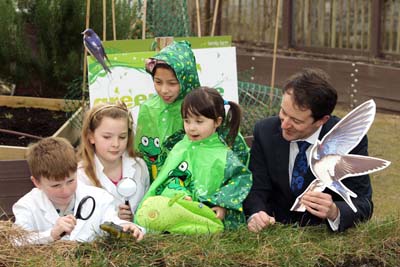Isabella Coleman, aged three, pictured at the launch of Greenwave 2012 at Dublin Zoo!
What are green waves? According to scientists, when Europe is viewed from outer space in springtime, you can see a green wave moving up across it. That’s why Irish primary school students are being encouraged to take part in the Irish segment of the European project Greenwave this year and to discover when spring arrives in Ireland.
Discover Science and Engineering is calling for all national primary schools to get involved with Greenwave 2012, the mass science project whereby students get to track the arrival of spring as it moves across the country.
When viewed from outer space, a ‘green wave’ apparently begins in the south of Europe in February. As the temperature rises, it moves up across Europe travelling at around 6.4 kilometres per hour – a similar speed at which a human walks.
Last year, 153 Irish primary schools took part in the Greenwave project, submitting 815 official records of common species and 4,572 weather observations.
This year, between February and March, students are invited to log their sightings of six species; ash, horse chestnut and hawthorn trees, the primrose, the swallow and frogspawn on Greenwave.ie. They are also asked to measure and record wind speed, rainfall and temperature.
The results will be recorded on the website in order to map the arrival of spring. The project also caters for Gaelscoileanna, as materials will be available in Irish on the website.

Rory Howe (aged 10); Sophie McWilliams (aged 10); Andreya Mooney (aged 9); and Isabella Coleman (aged 3), pictured with Minister Sean Sherlock, TD, at the launch of the Greenwave 2012 science initiative at Dublin Zoo
Speaking at the launch of Greenwave at Dublin Zoo, Minister Sean Sherlock spoke about how science, technology, engineering and maths (STEM) subjects are vital to the growth and progress of the Irish economy. “To ensure we maintain that priority, we have to teach our children to appreciate their significance from an early age,” he said.
Sherlock said the Greenwave initiative gives children an opportunity to engage with science in an interesting and fun way by monitoring the signs of spring.
Scientific education and developing ICT skills
Peter Brabazon, programme director Greenwave, at Discover Science and Engineering, said Greenwave is a practical way to get involved with the social, environmental and scientific education (SESE) curriculum in Ireland.
He said it also helps to develop students’ ICT skills in terms of recording and submitting their results online.
“I urge all primary schools to get involved with this exciting project and to play their part in recording the arrival of spring in Europe,” said Brabazon today.
Schools that do participate in the Greenwave project will have completed part of Step 1 of the Discover Primary Science and Maths, Awards of Science & Maths Excellence, said Brabazon.
During 2011, Greenwave was extended to 17 European countries ranging from Portugal and Greece in southern Europe to Denmark and Sweden in northern Europe. A total of 1,888 official records of a range of species and weather conditions were submitted from these countries onto the Greenwave Europe website.